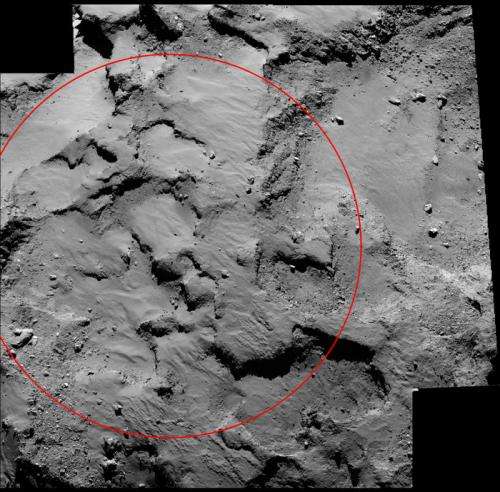How to land on a comet

Generally speaking, space missions fall into one of three categories: difficult, more difficult, and ridiculously difficult.
Flybys are difficult. A spaceship travels hundreds of millions of miles through the dark void of space, pinpoints a distant planet or moon, and flies past it at 20 to 30 thousand mph, snapping pictures furiously during an achingly brief encounter.
Going into orbit is more difficult. Instead of flying past its target, the approaching spaceship brakes, changing its velocity by just the right amount to circle the planet. One wrong move and the spacecraft bounces off the atmosphere, becoming an unintended meteor.
Landing is ridiculously difficult. Just play NASA's "Seven Minutes of Terror" video. Watching Curiosity parachute, retrorocket, and sky-crane its way to the surface of Mars rarely fails to produce goosebumps. Since the Space Age began, the space agencies of Earth have succeeded in landing on only six bodies: Venus, Mars, the Moon, Titan, and asteroids 433 Eros and Itokawa.
In a move that could set a new standard for difficulty, the European Space Agency is about to add a seventh member to the list. On Nov. 12th ESA's Rosetta spacecraft will drop a lander named "Philae" onto the surface of Comet 67P/Churyumov–Gerasimenko.
"How hard is this landing?" asks Art Chmielewski, the US Rosetta Project Manager at JPL. "Consider this: The comet will be moving 40 times faster than a speeding bullet, spinning, shooting out gas and welcoming Rosetta on the surface with boulders, cracks, scarps and possibly meters of dust!"
Rosetta will drop Philae from a height of 22 km as the comet rotates freely below. No active steering will take place during the slow descent.
"Unlike previous landings, where reconnaissance had been done beforehand—at Mars, for instance, we mapped the planet well in advance—Rosetta just started learning about its target a couple of months ago," explains Claudia Alexander, Project Scientist for the U.S. Rosetta Project. "This introduces much more risk."
Rosetta arrived at 67P on August 6, 2014. What it found was shocking. The comet's nucleus is strangely shaped, (one observer has likened it to a "freak-show mushroom") dominated by a pair of mile-wide "knobs" joined by a boulder-strewn "neck." Picking a landing site would not be easy.
Rosetta spent more than a month surveying the comet before engineers and scientists gathered in France to make their decision.
"None of the candidate landing sites met all of the operational criteria at the 100% level," says Stephan Ulamec, Philae Lander Manager at the German Aerospace Center (DLR), "but Site J is clearly the best solution."
Site J is a relatively flat, boulder-free location on the smaller of the comet's knobs. It gets plenty of sunlight for the lander's solar panels and has good line-of-sight visibility for communications with Rosetta orbiting overhead.
The descent will take about 7 hours, a drawn-out process that could be enlivened by unpredictable jets of gas emerging from the comet's core.
You thought 7 minutes of terror was bad? "This will be Seven Hours of Terror," says Alexander.
If all goes well, Philae will touch down at walking pace and deploy harpoons to fasten itself to the crusty surface. A suite of 10 sensors on the lander, including a drill for sample collection and an acoustic sounder to probe the comet's sub-surface structure, can then begin an unprecedented study of a comet at point-blank range.
"A comet is unlike any other planetary body that we've attempted to land on," says Alexander. "Getting Philae down successfully will be an incredible achievement for humankind!"
More information: Try your hand at landing a spacecraft on a comet with NASA Space Place's Comet Quest: spaceplace.nasa.gov/comet-quest/
Provided by NASA





















